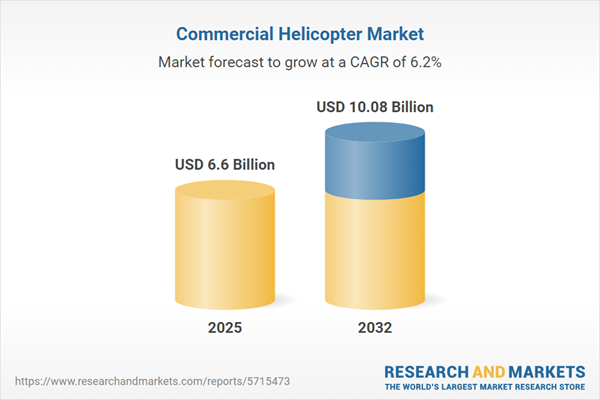Speak directly to the analyst to clarify any post sales queries you may have.
The commercial helicopter market is evolving rapidly, driven by innovation, strategic partnerships, and the need for greater efficiency across multiple sectors. As operators and manufacturers adapt to changing demands, this market is poised for steady expansion and increased complexity.
Market Snapshot: Commercial Helicopter Market Growth and Opportunity
The commercial helicopter market grew from USD 6.24 billion in 2024 to USD 6.60 billion in 2025, supported by a CAGR of 6.17%, and is projected to reach USD 10.08 billion by 2032. This momentum is underpinned by rising demand for mission-critical applications, operational advancements, and a heightened focus on performance and reliability in diverse geographies.
Scope & Segmentation
This report provides in-depth analysis of the commercial helicopter industry, examining the following segments and drivers:
- Type: Heavy, light, and medium helicopters each address unique requirements, from high-payload utility missions to agile urban operations and versatile mid-range tasks.
- Number of Engines: Multi-engine, single-engine, and twin-engine platforms deliver varied advantages in safety, cost, and mission adaptability.
- Fuel Type: Innovations include biofuel compatibility and electric propulsion, serving sustainability goals and reducing operational emissions.
- Rotor System: Multi-rotor, single main rotor, and tilt-rotor technologies enable a range of performance profiles, from unmanned to high-speed operations.
- End-Use: Applications span law enforcement, public safety, medical services, oil and gas, and passenger or cargo transport.
- Regions: Detailed insights are provided for North America, Latin America, Europe, Middle East, Africa, and Asia-Pacific, covering key countries in each to reflect diverse market dynamics.
- Key Companies: The competitive landscape includes Airbus SAS, Bell Textron Inc., Leonardo S.p.A., The Boeing Company, and other organizations advancing airframe and service standards.
Key Takeaways for Senior Decision-Makers
- Advanced avionics and automated controls are raising operational safety and efficiency, enabling quicker design customization and improved reliability.
- Strategic partnerships between OEMs, suppliers, and service firms are enhancing resource allocation and driving the adoption of technologies like hybrid propulsion and digital predictive maintenance.
- The shift towards service-based business models, including subscription and managed fleet solutions, is enabling operators to improve utilization and manage costs effectively.
- Sustainability pressures are leading to widespread adoption of low-emission systems, with biofuel-ready and electric helicopters reshaping lifecycle planning and infrastructure requirements.
- Regional market differences drive innovation, with markets like North America emphasizing advanced maintenance, while regions such as Asia-Pacific accelerate rotorcraft adoption for logistics and emergency services.
- The role of digitalization—ranging from remote diagnostics to virtual training platforms—is becoming a foundational differentiator among leading operators and service providers.
Tariff Impact
Recent United States tariff policies have increased acquisition costs for imported components, compelling operators to reconsider sourcing strategies and accelerate investments in local supply chains. Manufacturers are forging new partnerships with regional suppliers and prioritizing domestically produced assemblies to mitigate trade risks. As a result, there is a trend toward cost containment and vertical integration, with companies optimizing fleet schedules and adopting aftermarket retrofits to manage rising expenses while maintaining quality standards.
Methodology & Data Sources
Research combines interviews with industry executives, technical experts, and program managers at leading OEMs. Analysis draws from regulatory documents, patent filings, operational data, and verified secondary sources, including government statistics and industry group reports. Findings were cross-validated through expert workshops to ensure reliability and reduce bias.
Why This Report Matters
- Enables strategic planning by highlighting emerging trends, disruptive technologies, and evolving use cases across global regions.
- Supports informed procurement and investment by detailing the business impact of regulatory changes, including tariffs and sustainability standards.
- Equips senior stakeholders with actionable recommendations to build resilient supply networks and capitalize on digital transformation for competitive advantage.
Conclusion
The commercial helicopter market is adapting to technological, operational, and regulatory change through innovation and collaboration. Decision-makers can leverage these insights to position their organizations for future growth and operational resilience.
Additional Product Information:
- Purchase of this report includes 1 year online access with quarterly updates.
- This report can be updated on request. Please contact our Customer Experience team using the Ask a Question widget on our website.
Table of Contents
3. Executive Summary
4. Market Overview
7. Cumulative Impact of Artificial Intelligence 2025
Companies Mentioned
The companies profiled in this Commercial Helicopter market report include:- Airbus SAS
- ANTONOV company
- Bell Textron Inc.
- Bristow Group Inc.
- Enstrom Helicopter Corporation
- Gulf Helicopters Company Q.S.C.
- Hindustan Aeronautics Limited
- Kaman Corporation
- Kawasaki Heavy Industries, Ltd.
- Leonardo S.p.A.
- Lockheed Martin Corporation
- MD HELICOPTERS LLC
- Motor Sich JSC
- Robinson Helicopter Company, Inc.
- Rostec Corporation
- Russian Helicopters JSC
- The Boeing Company
Table Information
| Report Attribute | Details |
|---|---|
| No. of Pages | 183 |
| Published | November 2025 |
| Forecast Period | 2025 - 2032 |
| Estimated Market Value ( USD | $ 6.6 Billion |
| Forecasted Market Value ( USD | $ 10.08 Billion |
| Compound Annual Growth Rate | 6.1% |
| Regions Covered | Global |
| No. of Companies Mentioned | 18 |









